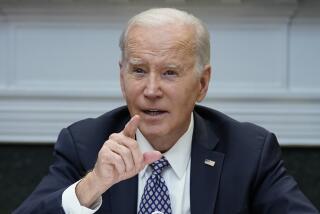Fragile economy takes toll on jobs
- Share via
WASHINGTON — The nation shed 62,000 more jobs in June, bringing total losses for the year to 438,000 and rekindling concerns that the United States is in recession.
What’s more, the Labor Department’s unemployment report, released Thursday, showed job losses in April and May were significantly deeper than initially thought. That contraction, combined with higher gas prices, suggests weakness ahead in consumer spending, which accounts for about 70% of economic activity.
“The economy has entered a slow-motion recession,” said Dean Baker, co-director of the Center for Economic and Policy Research, a Democratic-leaning think tank. “It is not seeing the dramatic plunges in jobs that characterized prior recessions, but the collapse of the housing bubble is slowly sinking more and more sectors of the economy.”
The economic stimulus payments the government issued to taxpayers in the last few months have helped ease the strain of higher energy prices, but that boost is about to fizzle out, said Joel Naroff of Naroff Economic Associates in Holland, Pa.
“When people run out of rebate money for gasoline and food, they will be in trouble,” Naroff said. “This tepid, limping economy will be with us for a while. We’re not crashing and burning; it’s just not an economy that’s going anywhere.”
The news could have been worse. The unemployment rate was unchanged after shooting up from 5% in April to 5.5% in May, the biggest one-month jump since 1986. And job losses were in line with expectations, contributing to a stock rally on Wall Street.
But some economists took little comfort in the flat unemployment rate. They noted that many workers have stopped looking for jobs altogether and are not being counted among the jobless because they have not actively sought new employment within the last four weeks.
“Many more adults are sitting on the sidelines, neither working nor looking for work,” said Peter Morici, an economist at the University of Maryland. “Factoring in discouraged workers raises the unemployment rate to about 7.2%.”
In addition to the 8.5 million Americans counted as unemployed, an additional 5.4 million were working part time because they were unable to find full-time work, the government said. About 1.6 million others were “marginally attached” to the labor market -- that is, they had looked for work sometime in the last 12 months but had become discouraged, entered school or decided to stay home to care for family.
Not surprisingly, some of the steepest job losses were in the troubled housing sector, which has been walloped by falling home values and foreclosures against borrowers who can’t make escalating payments on adjustable-rate loans.
Construction, depressed by the collapse of the housing market, lost an additional 43,000 jobs in June. Since its peak in September 2006, construction employment has fallen by 528,000. An additional 33,000 jobs were lost in the manufacturing sector.
But there were also signs of weakness in other areas, including retail trade and financial services. Government jobs were a bright spot, accounting for 29,000 new positions, and there was hiring in the healthcare and hospitality sectors. But those gains were outpaced by the losses in other parts of the economy.
Altogether, the private sector contracted by 91,000 jobs. Generally, the economy must create about 100,000 jobs a month to keep pace with the increasing population; this year, the economy has lost an average of 73,000 jobs a month.
The employment reports for April and May, meanwhile, were revised downward to show an additional 52,000 job losses.
“It’s persistent bad news,” said Diane Swonk, chief economist with Mesirow Financial in Chicago. “The economy is growing, but realistically it feels like a recession to most people.”
Recessions are generally defined as periods when gross domestic product slips into negative territory for two or more consecutive quarters. But the National Bureau of Economic Research, the panel that makes the official designation of a recession, tends to use a more complex analysis that emphasizes job creation and industrial production.
The economic bureau usually waits until downturns are over before applying the “recession” label. But economists said the sense of a downturn is so strong that an official declaration has become almost irrelevant.
“Technically, we’re probably not in a recession, but that doesn’t matter,” Naroff said. “It feels as if we are, and that’s much more critical than any definition.”
Soaring oil prices are not making the job picture any brighter, said Steven Davis, a labor economist at the University of Chicago. He said uncertainty about how high energy prices could climb may keep some firms from investing in new plants and new workers.
“Oil prices are high, but there is also a lot of uncertainty about whether they will go higher,” Davis said. “The answer to that question has a big impact for businesses in terms of what kinds of capital equipment they will adopt. This uncertainty is also depressing economic activity and hiring.”
In New York futures trading Thursday, oil closed at a record $145.29 a barrel, up $1.72, or 1.2%. Traders pointed to market nervousness about tension in the Mideast and fears that global fuel demand may test tight oil supplies.
--
More to Read
Inside the business of entertainment
The Wide Shot brings you news, analysis and insights on everything from streaming wars to production — and what it all means for the future.
You may occasionally receive promotional content from the Los Angeles Times.










